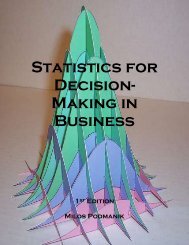English 101 Grading Rubric
English 101 Grading Rubric
English 101 Grading Rubric
Create successful ePaper yourself
Turn your PDF publications into a flip-book with our unique Google optimized e-Paper software.
GRADING RUBRICENG<strong>101</strong>_______ An "A" paper meets assignment requirements in an outstanding way. The writer focuseson a purpose, develops ideas thoughtfully and thoroughly with that purpose in mind, and consistentlyaddresses the audience’s needs. The paper begins in an engaging way. The writer effectively developsand supports positions and assertions with relevant details from well-chosen, appropriate sources. Itmoves beyond summarizing or reporting to integrating the writer’s ideas with those of others, asappropriate. Ideas are sequenced logically, with artful transitions that enhance unity and help thereader understand the progression of thought. The conclusion encourages insight, reflection, or action.The paper may "come alive" as a result of vivid or creative written expression. The writer variessentence structure effectively and uses grammar and mechanics appropriately. The paper reflectscareful proofreading on the part of the writer. Citations and documentation are placed and formattedcorrectly, as needed.________ A "B" paper meets assignment requirements successfully. The writer’s purpose may notbe consistently clear but may be implied. While most ideas are developed in detail, some may bedeveloped only generally or without sharp focus. The paper begins with an adequate introduction.Positions and assertions are supported with details from appropriate sources. The paper includes someanalysis, synthesis, or evaluation to integrate the writer’s ideas with those of others, as required.Common transitions are used, but the reader may not always clearly follow the progression of thought.The conclusion does more than summarize the paper. Word choice is accurate and descriptive;sentence structure is varied. Minor errors of grammar and mechanics are not distracting or confusing.As needed, citations and documentation are placed and formatted correctly, with only minor errors.________ A "C" paper meets assignment requirements adequately. The reader may be forced toassume the writer’s purpose. Thinking may appear to be superficial or illogical, and ideas may bedeveloped only generally. The paper may begin without engaging the reader. It may lack relevantsupporting details from appropriate sources. Ideas of others may only be summarized without analysis,synthesis, or evaluation. Transitions may be used unevenly throughout the paper; the sequence of ideasmay be disorganized or hard to follow. The conclusion may only summarize the paper. Word choicemay be reasonably accurate but not descriptive. Sentence structure may lack variety and/oreffectiveness. Errors of grammar and mechanics may distract or confuse the reader. If citations anddocumentation are required, there may be frequent minor errors or occasional major errors.________ A "D" paper is less than adequate. The writer’s purpose is lost or unclear. Ideas remainundeveloped assertions without supporting detail. The paper shows little or no thinking beyond theobvious and general. The writer does not effectively analyze, synthesize, or evaluate the ideas ofothers. The paper may lack transitions and a clear progression of thought. Conclusion may be missingor inappropriate. Word choice and sentence structure may be awkward. Errors of grammar andmechanics may be so frequent that they overwhelm the reader. Citations and documentation may beincorrect or lacking._________ An “F” paper lacks evidence of process, does not respond to the assignment, isunintelligible, or demonstrates evidence of plagiarism.Last updated 12 August 2007
QUALITIES OF COLLEGE-LEVEL WRITINGENG<strong>101</strong>RHETORICAL KNOWLEDGE• Focuses on a purpose and develops ideas thoughtfully and thoroughly with thatpurpose in mind.• Anticipates and addresses different audiences’ needs.• Demonstrates the writer’s knowledge or experience of the topic.• Begins in an engaging way appropriate to the writer's purpose and audience.• Effectively supports positions and assertions with relevant details.• Sequences ideas logically and effectively for the purpose and the audience.• Concludes beyond summarizing to encourage insight, reflection, or action.• Writes with a tone that is appropriate for the purpose and audience.• Allows the reader to have a sense of interacting with the writer.CRITICAL THINKING• Uses writing and active reading to inquire, learn, think, and communicate.• Selects and evaluates appropriate primary and secondary sources.• Develops ideas with relevant details from well-chosen, appropriate sources.• Moves beyond summarizing or reporting to integrating the writer’s ideas withthose of others through analysis, synthesis, and evaluation.• Takes into consideration alternative viewpoints on the topic.KNOWLEDGE OF CONVENTIONS• Uses topic sentences and transitions to enhance coherence and unity.• Varies sentence structure to reflect the complexity of the writer’s ideas.• Avoids clichés, colloquialisms, slang, and convoluted language and instead usescollege-level vocabulary to make the writing precise and lively.• Uses grammar and mechanics appropriately.• Demonstrates careful proofreading by correcting typos and errors.• If used, citations and documentation are placed and formatted correctly in MLA style.Last updated 12 August 2007
















